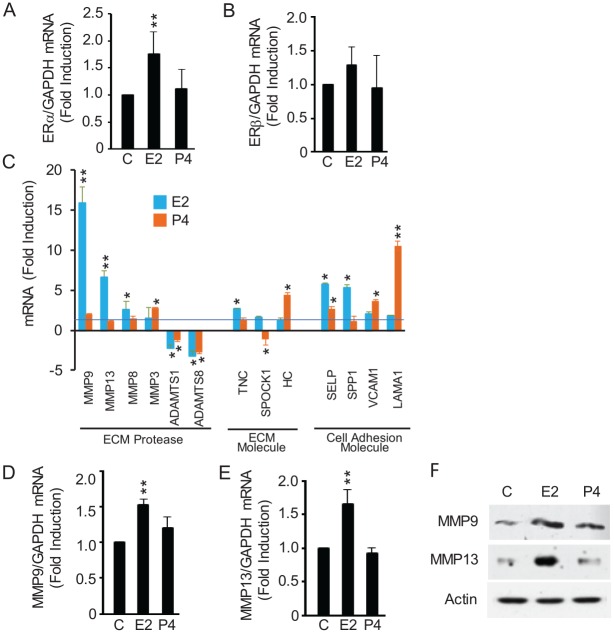Figure 2.
E2 enhances the expression of ERα and specific MMPs in TMJ fibrocartilage in vivo. Mice were treated as in Figure 1. Total RNA and protein were extracted from TMJ fibrocartilage and assayed by real-time qRT-PCR, gene array, and Western blots. (A, B) E2 but not P4 enhanced ERα mRNA expression, while neither hormone modulated ERβ mRNA expression. (C) RT2 Profiler gene array data of the 13 assayed mRNAs (out of 84) that are significantly modulated by E2 and/or P4 demonstrate the specificity and magnitude of E2’s induction of MMP9 and MMP13. (D–F) Real-time qRT-PCR and representative Western blot confirming E2’s induction of MMP9 and MMP13 in vivo. Results are presented as mean ± SD from 5 mice. *P < 0.05 and **P < 0.01 vs. control. C, control (phosphate buffered saline); E2, 17-β estradiol; ER, estrogen receptor; MMP, matrix metalloproteinase; P4, progesterone; qRT-PCR, quantitative reverse transcription polymerase chain reaction; TMJ, temporomandibular joint. Abbreviations of genes in panel C are as follows: ADAMTS1 and ADAMTS8: a disintegrin and metalloproteinase with thrombospondin motifs 1 and 8; HC: hemolytic complement; Lama1: laminin alpha 1; Selp: selectin platelet; SPOCK1: SPARC (osteonectin), CWCV and Kazal like domains proteoglycan 1; Spp1: secreted phosphoprotein 1; TNC: tenascin C; Vcam1: vascular cell adhesion molecule 1.

